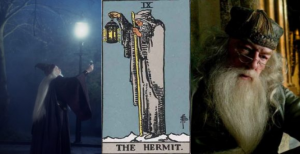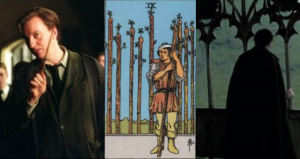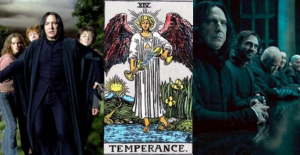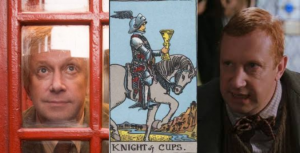Five Wizarding World Wizards as Tarot Cards
The correlation between tarot and the wizarding world doesn’t stop with witches! This ancient art reveals itself in wizards too. From the ever-popular Hermit card to the little-known Nine of Wands, the tarot is flush with archetypes and traits that are all too familiar to the Potter fan!
The Knight of Cups
The Knight of Cups, unlike the other knights of the deck, is not interested in battle or defense. He is driven by his creativity, curiosity, and compassion. What better words describe the patriarch of our favorite red-headed family, Arthur Weasley? His interest in Muggles permeates almost his entire life, including his job at the Misuse of Muggle Artifacts Office. This career allows Arthur to see up close and personally the Muggle artifacts that he is so curious about while also protecting Muggles from the various misuses of them by wizards. As we’ve seen, Arthur has a habit of using his own loopholes in the Muggle artifact laws in order to do some dabbling with Muggle things himself, displaying the Knight of Cups’ creativity, intense curiosity, and eagerness to learn.
The Hermit

Wisdom, introspection, solitude — these three main keywords of this famous tarot card immediately show similarities between the Hermit and Albus Dumbledore. From the very beginning of the series, Dumbledore takes on the “wise old man” mentor archetype, offering Harry advice and comfort, most often from his secluded tower office. A trait often ascribed to the Hermit is retreating into solitude in order to heed the wisdom that few others would follow. This perfectly describes Dumbledore’s actions in Harry’s journey to defeat Voldemort. Accused by Snape of raising Harry like a pig for slaughter, Dumbledore knew that the sacrifice of one would save the lives of many. Because of this, Dumbledore isolated himself and his plans until the moment was right.
The Nine of Wands

The Nine of Wands describes a person who has many faced battles, both internal and external. Many of his battles are faced alone, and he continues to stand up in the face of adversity. Keywords for this card include struggles, injury, resilience, solitude, and wisdom from experience. Some of Remus Lupin’s battles include being bitten by a werewolf as a child, being shunned by wizarding society for who and what he is, and forcing himself into solitude as a direct result of these experiences. Though on the surface Remus appears battered and worn, he carries on through his own struggles and helps others through theirs as well. As a teacher, Lupin teaches defense against creatures rooted in dark emotions – boggarts in fear, and dementors in depression. He uses his own wisdom gained through experience with negative emotions in order to teach students how to overcome fear with laughter, and depression with love, happiness, and chocolate.
The Six of Wands

The Six of Wands is a card of success and victory, generally in relation to leading others. As the main hero of the series, Harry experiences several valiant successes, but none are nobler than when he is leading Dumbledore’s Army. Basically the student version of The Order of the Phoenix, it was a wonder that under the reign of Umbridge Harry got the DA started at all. A trait of the Six of Wands is being able to rouse hope, excitement, and action in others. Harry does just that at the first meeting of the DA, promising true defense lessons that students weren’t receiving in Umbridge’s class. In the meetings to follow, Harry uses teaching techniques picked up from Professor Lupin, building his classmates up and helping them through their difficulties. Through this method of teaching, he keeps their hope and excitement high, successfully teaching simple spells like Expelliarmus and more difficult spells like the Patronus Charm. As the head of the DA, Harry eventually leads a charge against the Death Eaters at the Ministry of Magic, putting their hard work and practice into action.
Temperance

Temperance is a card of patience, balance, and staying true to your ultimate purpose. Severus Snape is one of the most debated characters of the entire series — some say he’s a hero; some say he’s a creep. But one thing no one can dispute is that after Voldemort marked Lily Potter for death, Snape stayed true to Dumbledore, the Order, and his own ideology of justice until the moment of his death. He was able to keep one foot in the Order and the other in the world of the Death Eaters, just as the figure in Temperance keeps one foot in the water and one on land. Because of this balance, the Order was able to gain intelligence surrounding Voldemort’s plans and plant information of their own. Snape’s work for over a decade shows the patience and dedication inherent in the Temperance card, and though he didn’t live to see it, he was instrumental in the ultimate defeat of the wizard who killed Lily Potter.
These are only some of the interrelations of the classic tarot deck and the wizards of the Harry Potter series. Where do you see similarities between these two magical works?


